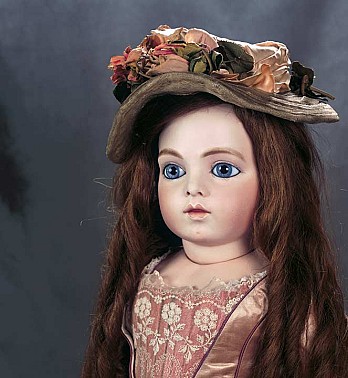French Bisque Poupee by Adelaide Huret with Trousseau and Victor Hugo Provenance
Lot #19
17" (43 cm.) Pale bisque swivel head on kid-edged
shoulder plate with distinctive plump facial
modeling and strong throat,defined double chin and
characteristic throat hollow at top of shoulder
plate,painted eyes in deeply-set sockets with
outlined heavy eyelids,characteristic decorative
glaze at lower eyes,painted
lashes,lightly-feathered brows,accented nostrils
and eye corners,closed mouth with pale
daintily-accented lips,unpierced
ears,strawberry-blonde human hair over cork pate
arranged in a stylized topknot,gutta-percha
fully-articulated body with jointing at
shoulders,elbows,hips and knees,and wearing a
stunning ice-blue silk dress with cream
pencil-stripe design,scalloped edging and
feather-stitched embroidery,ivory silk
ribbons,over sous-sleeves,with
undergarments,classic Huret heeled shoes with
darker sole rims and an impressed block mark,and
turquoise bead necklace with opaline cross.
Condition: generally excellent,typical repairs to
gutta-percha body. Marks: Medaille d'Argent
Huret,22 Boulevd Montmartre Paris Expos. Univers.
1867. Comments: Adelaide Huret,circa 1863,the doll
served as inspiration for the heroine Deruchette
of Victor Hugo's novel,Travailleurs de la Mer,was
then gifted by Victor Hugo to the daughter of his
dear friend Alfred Asseline (who named her "The
Great Man's Doll"),and finally,in 1872,after the
Hugo family's return to Paris from exile,she was
presented to his grand-daughter Jeanne after a
re-freshening visit to the Huret ateliers where
the body was restored,a kid label with the 1867
Exposition label affixed,and beautiful additions
made to the trousseau. The doll remained among
Jeanne's belongings most of her life,and was then
gifted to her god-daughter in whose family the
doll remained until the present time. A more
detailed story of the doll is given in an appendix
at the end of this catalog. Value Points the
extraordinary provenance concerning the man whom
many consider France's finest poet/writer is only
enhanced by the exceptional beauty of this Huret
doll. In addition,the poupee owns an extensive
trousseau,once cherished by Jeanne Hugo,as
attested by the linen-covered wooden doll trunk
which bears the brass name plate of "Jeanne". The
costumes comprise seven additional dresses and
gowns of couturier quality from the early/mid 1860
era,and one superb silk fashion gown from the 1872
era that bears the Huret stamp on the inside waist
(according to The Huret Book by Francois
Theimer,labeled Huret costumes from this era were
special commission only,suggesting the gown had
been ordered by Victor Hugo for his
granddaughter's doll). There are also two pique
petticoats and a half slip that have the Huret
stamp,and nine other finely-made undergarments.
Other signed Huret accessories include bone
folding fan in box labeled Huret,hat box labeled
Huret containing two silk flowers and a blue woven
bonnet signed Huret,pressed flannel bonnet. and a
green-edged white box with Huret stamp containing
a hankie embroidered "H". Other accessories
include: black silk and lace
coiffe,stiffened-braid bonnet with green
feathers,two metal-handled parasols (one black
silk with ivory tips,and one painted yellow with
unusual silk cover and ivory tips),miniature rare
blue opera glasses (one brass rim missing) with
Stanhope image of Rouen and a drawing of Jeanne
(symbol of France) in the manner of Hugo's
illustrations,leather purse with tiny lock of baby
hair,finely-woven silk snood,needlepoint
slippers,knit fingerless gloves with blue silk
ribbons,wooden egg,lambswool muff in original
green box,wooden game box with cards and dice,gilt
metal crown,leather cased necessaire with bone awl
and needlecase and tiny gilded scissors,little
book,very fine handmade lace coiffe and veil,silk
pillow with woven design "Souvenir de L'Exposition
1878",and a fine porcelain tea service in its
original box. Also included is a first edition of
the 1885 memoirs,Victor Hugo Intime,by Alfred
Asseline,detailing the early history of the
poupee,and a hand-written letter by Micheline
Cullin of Paris,the final family owner of the
doll,relating more details of the doll and its
history.






























































































































































































































































































































































































































































































